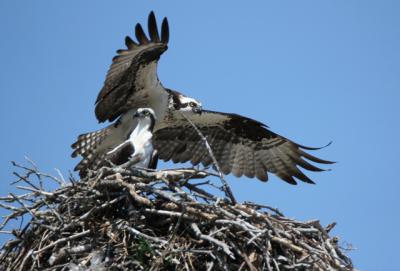Nature Notes: It’s Not for the Romance

There’s an old saw that says “there’s more than one way to skin a cat.” It doesn’t actually have to do with removing the pelts from cats, thank God, but more with alternative ways of getting something done that needs to be done. In humankind as in nature, just about every method to get a given thing done has been tried. Some methods fail outright, some work for a while, then others that are more durable and efficient replace them; a few work forever with little change over countless eons, thus the horseshoe crab.
It’s the story of evolution.
Take reproduction in humans and other animals, for that matter. Most religions tout monogamy as the key to stable, successful, and ethical child rearing. And for a long time in most societies based on all forms of Christian religion, it was the standard, and it is still the orthodox way of bearing young, caring for them, and, eventually, weaning them. It works more times than not.
But what about monogamy as a chosen form in other vertebrate animals, say, in birds, or mammals? It turns out that most songbirds are monogamous in the short run, for a single breeding season. Only a few birds are monogamous year after year after year. Long before ornithologists came along and established the fact that mature bald eagles remain with each other year after year, and use the same nest year after year, and produce a litter year after year, they became our national bird.
Locally and around the world, the osprey is monogamous in the same way. A nest on a pole in Napeague was used by the same pair of ospreys for more than 20 years. When one of the pair died in a tragic accident, a new mate was secured during the off-season and taken to that nest the following spring. Most of us applaud the bald eagle and the osprey for their monogamous ways.
Most of us also treasure the eastern bluebird, the official state bird of New York. However, if we studied bluebirds, we would discover that some hanky-panky frequently goes on and a bluebird litter in a bluebird box often contains young from different parents. The same is true of the beautiful cardinal: Any given cardinal nest has a one-in-three chance of containing eggs from two different parents. However, notwithstanding some backdoor antics in avian society, 90 percent of bird species are monogamous for at least a single breeding season.
Ironically, ospreys, bald eagles, and bluebirds were not faring well during the 1960s, 1970s and 1980s, but it had little to do with their social or reproductive habits and more to do with the various insecticides, such as DDT, that were incorporated into their diets, then into their eggs. Whooping cranes, common puffins, condors, black vultures, Laysan albatrosses, Canada geese, mute swans, and red-tailed hawks are also monogamous throughout a lifetime, or at least for as long as both members of a pair are alive. It is as convenient as it is romantic and idealistic
Some reptiles, such as crocodiles, show extended mother-protect-eggs-protect-hatchlings behavior, but unless science proves differently, most are not monogamous. Monogamy would be a liability for amphibians like salamanders, frogs, and toads that breed in water. Take, for example, if spadefoot toads that only climb out of the ground after torrential rains to breed in temporary ponds had to find their one-and-only mates in the dark of night while it was pouring down, their chances of breeding successfully would be very low indeed.
The same goes for fish, almost all of which breed in an aqueous environment, many times after a long run upstream, tired and exhausted. Yes, some males — sharks, live-bearing minnows, and a few other species — have gonopodia, or intromittant organs, for sperm insertion, to insure that their sperm reach “touchdown.” They are not monogamous per se. Indeed, in some fish species, like pipefish and seahorses, the males raise the young after taking them into their protective pouches.
Humans are mammals, the so-called highest order of animals in the animal kingdom. What do most mammals do? Well, in the hoofed animals and apes, most females in a herd or tribal group are inseminated by a few select males. Such is the way of the much-maligned white-tailed deer. In almost all mammals, after the act of copulation occurs, the female focuses all her energies on having a successful in vivo experience followed by successful birthing and upbringing of the young. In felines, the males are completely superfluous once the act of insemination is completed.
L.G.B.T. may be a new term in human culture, but it has existed in lower animals for millions of years, but quietly so, not advertised. In humans, monogamous relationships provide security, a stable home in which to rear children, and the like.
However, the world is changing rapidly. There are societies in which women greatly outnumber men, and only a few where there are more men than women. But then again, the act of love can easily be replaced by artificial insemination. Women can have babies and rear them to fruition without having to take care of a mate simultaneously. As I see it, the future of humans is a great crapshoot. New forms of culture will continually be invented, others reinvented, some will persist for generations, others like the “summer of love” will fail outright. It may be that classical music will finally die out and rap music outlive us all. Bah, humbug.
Larry Penny can be reached via email at [email protected].
